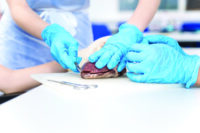There are 4 main types of tissue: epithelial, muscle, nervous, and connective. Each type has a particular function and can be found to some degree in most organs. In order to understand the structure and function of each type of tissue, it is important to view them microscopically. Many tissues viewed with the naked eye appear to be made of the same thing, but viewed under the microscope appear very different, indeed. Students will be able to fully comprehend the concept that tissues are groups of specialized cells that work together for a particular function.
The following excerpt shows how you can integrate prepared microscope slides from the Introductory Histology Slide Set into the study of each mammalian system. This excerpt is taken from the Carolina® AP® Biology Mammalian Structure and Function Dissection Kit Teacher’s Manual, which suggests using the Introductory Histology Slide Set as an extension activity to enhance the dissection.
External anatomy
Have students view the Mammal Skin slide as an example of stratified squamous epithelium. Students should identify the following structures within this tissue: squamous superficial cells, stem cells, basal lamina, and connective tissue. Next, direct students to research and identify the function of this type of tissue and other areas of the body where this tissue may be found. Finally, have students view the Mammal Adipose Tissue slide and direct them to identify the adipocytes and discuss the locations and functions of this tissue.
The muscular system
Have students view the following slides: Mammal Smooth Muscle, Mammal Skeletal Muscle, and Mammal Cardiac Muscle. Students should compare and contrast the appearance of the 3 types of muscle, and identify the locations and functions of each.
The digestive system
Have students view the following slides: Mammal Foliate Papillae with Taste Buds, Mammal Liver , Mammal Fundic Stomach, Mammal Jejunum, and Mammal Colon. Have students identify the type of tissue on each slide and discuss why this type of tissue is appropriate for the area where it is found. Next, have students view the Amphibian Simple Columnar Epithelium and identify the type of tissue on this slide. Direct them to compare this slide to the previously viewed mammal digestive tissue slides. To which mammal digestive tissue slides is it most similar? Have students try to determine from which area of the amphibian this tissue was taken. (The Amphibian Simple Columnar Epithelium is taken from the intestine of Amphiuma, an aquatic salamander.)
The urogenital system
Have students view the Mammal Kidney slide and the Mammal Ovary Follicles slide. Direct them to describe the tissue of each slide and identify the type of tissue on each slide. Have students describe why this type of tissue is appropriate for this area of the body.
The circulatory system
Have students view the Human Blood Smear slide and identify the 3 types of cells found in blood: red blood cells, white blood cells, and platelets. Have them view the Mammal Aorta slide. Students should identify the 3 layers of this artery: the tunica intima, tunica media, and tunica externa. Have them research and explain the differences in these layers, and explain how these layers may differ between arteries and veins. Finally, ask students to view the Human Spleen slide and identify the type of tissue found on this slide. Why is this tissue appropriate for the area where it is found?
The respiratory system
Have students view the Mammal Lung slide and describe the different types of tissues that they find.
The nervous system
Have students view the Mammal Cerebrum and Mammal Cerebellum slides and compare the cellular makeup of each. Direct them to view the Mammal Spinal Cord slide and identify the major landmarks, or areas, of the spinal cord. Have students view the Mammal Peripheral Nerve and describe the structure of the nerve tissue.
The skeletal system
Have students view the Mammal Elastic Tissue slide. Direct them to describe the structure of this tissue and identify its locations and functions. Next, have students view the Mammal Compact Bone slide and identify the structures of compact bone, such as Haversian canal, blood vessels, and lamellae. Last, ask student to view the Bone Developing Membrane slide and compare it to the Mammal Compact Bone slide.
A comprehensive set for beginning histology study
Carolina’s Introductory Histology Slide Set includes 25 slides representing the 4 major tissue types: epithelial, muscle, nervous, and connective. As suggested above, students may:
- Study each slide and identify the tissue type(s) present
- Compare the functions of different tissue types present in the same slide preparation
- Compare and contrast tissues from different slides
The teacher’s manual that accompanies the slide set gives brief information about each slide in the set.
Learn more
Carolina offers hundreds of prepared slides to help you teach about mammalian tissues and organs. If you want help finding the perfect slide or slide set, our trained staff in the Microscope Slide Department will happily assist you. For more information about our vast array of microscope slides and sets, call 800.227.1150 and ask for the Microscope Slides Department or visit www.carolina.com.





























2 Comments
I´m Professor of Veterinarian Histology and Pathology at the University of the Azores. So, I’m interested to buy some collections of slides from the main body systems. Our model is Human hstology. Could you please help me to find slides sets of the differents systems and organs?
Is it possible to import to Portugal these kind of didactic material? This can made by a accredited commercial company.
Please reach out to our International Sales department and they will be able to assist with the sourcing, and shipping.